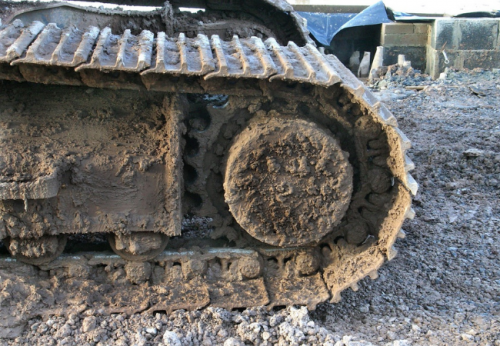Excavating and Drilling in Wet Weather

The Northern California rainy season has begun, and with it come special challenges for construction project crews.
The most common wet weather dangers are “slips, trips and falls.” These dangers are particularly prevalent when working in elevated positions such as when using scaffolding, hand holds, stairs and ladders. Even after the rain stops, conditions remain muddy underfoot for days.
Strong winds create their own hazardous conditions, scattering unsecured materials and putting pressure on scaffolding. Wet and windy weather can also make driving and operating excavation machinery more dangerous due to slick conditions and reduced visibility.
Weather wear and tear on excavation equipment and workers
The most basic change is soil saturation. Water is heavy. Lift a gallon of water and you will see what we mean. Soak gallons of water into the soil and very quickly that dirt can triple or quadruple in weight. That means workers and machines have to exert much more energy to move the same cubic feet of dirt (which is now mud.) In our work, both drilling and excavating have to manipulate saturated soil. Dump truck that haul soil away also have weight limitations.
Saturated soil also doesn’t hold its position as well as dry soil. Bay Area trenching work becomes much more hazardous in rainy weather because the trench walls are more apt to collapse and will need more active shoring techniques.
Excavation and Drilling Site Safety
Precautions to take during adverse weather conditions could include:
- Ensuring workers are provided with the necessary skills to identify wet weather related hazards and the steps to take to minimize risk.
- Setting up workbenches on solid, clean surfaces, protected as much as possible from the elements.
- Ensuring all power tools are properly maintained and electrical leads are designed for outdoor use.
- Keeping the site clean and tidy. Avoiding slips by being on the lookout for puddles and debris.
- Wearing appropriate PPE (Personal Protective Equipment) including the use of anti-fogging eye protection.
- Wearing the right gloves for the task, that offer enough insulation to keep hands warm, but thin enough to maintain feel and dexterity.
- Wearing several layers of clothing, not one thick layer.
- Safety shoes/boots need to have anti-slip soles and sufficient tread to prevent slips or falls on wet surfaces. Gumboots may be required as a control measure for trench work and extremely muddy sites.
- Where heavy rain is forecast, open trenches, excavations, scaffolding (support) and lift wells and pits may quickly become hazardous and need to be reviewed.
- Suspend work on certain sites if the rain gets too heavy or the wind too strong.
We have a safety-first culture at Lassiter Excavating
With continual training that mindset becomes second-nature, and ensure safe yet efficient work gets done in most weather conditions, even with Bay Area trenching work. Contact us for excavation and drilling subcontracting work, and Bay Area and Sacramento pool demolition.

